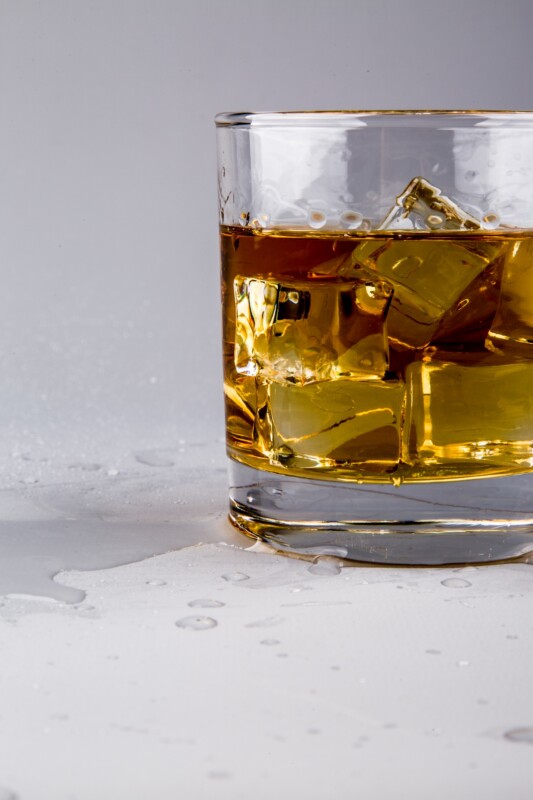
Whiskey is a popular alcoholic beverage that has been enjoyed for centuries. It is a type of distilled spirit made from fermented grains such as barley, corn, rye, or wheat. Whiskey is produced in many countries around the world, including Scotland, Ireland, the United States, Canada, and Japan.
 photo credit: www.publicdomainpictures.net
photo credit: www.publicdomainpictures.net
One of the most common questions that people have about whiskey is what it tastes like. The taste of whiskey can vary widely depending on the type of whiskey, the ingredients used, and the aging process. Some whiskeys are sweet and fruity, while others are smoky and robust. Some have a hint of vanilla or caramel, while others have a spicy or oaky flavor. Understanding the different types of whiskey and their flavor profiles can help you choose the right whiskey for your taste preferences.
Table of Contents
Understanding Whiskey
Whiskey, also spelled whisky, is a distilled alcoholic beverage made from fermented grain mash. It is typically aged in wooden casks, which gives it its distinctive flavor and color. Whiskey is a complex spirit that can be enjoyed in many different ways.
The taste of whiskey can vary widely depending on the type of grain used, the distillation process, and the aging process. Some common flavors found in whiskey include vanilla, oakwood, toasted grains, toasted nuts, and smoky undertones. The flavor profile of whiskey can also be influenced by the type of cask used during the aging process.
Whiskey is typically classified into several different categories based on the type of grain used. Some of the most popular types of whiskey include:
- Bourbon: Made from at least 51% corn and aged in new, charred oak barrels.
- Rye: Made from at least 51% rye and aged in charred oak barrels.
- Scotch: Made from malted barley and aged in oak barrels for at least three years.
- Irish: Made from a mixture of malted and unmalted barley and aged in oak barrels for at least three years.
Whiskey Flavor Profiles
When it comes to the flavor of whiskey, there is a wide range of notes that can be experienced. The flavor profiles can be influenced by various factors such as the type of grain used, the aging process, and the type of barrel used. In this section, we will explore some of the most common flavor profiles found in whiskey.
Sweet
Many whiskey varieties have a sweet flavor profile, with notes of caramel, vanilla, and honey. Bourbon, in particular, is known for its sweet taste, which is attributed to the use of new American Oak barrels in the aging process. These barrels add a sugary sweetness to the whiskey, making it taste almost like candy.
Smoky
Some whiskey varieties have a smoky flavor profile, which is often attributed to the use of peat in the malting process. Scotch whiskey, in particular, is known for its smoky flavor, which is often described as tasting like a campfire. The smokiness can also be influenced by the type of barrel used in the aging process, with charred barrels adding a smoky flavor to the whiskey.
Woody
Whiskey aged in oak barrels often has a woody flavor profile, with notes of oak, cedar, and other woods. The longer the whiskey is aged, the more pronounced the woody flavors become. The type of oak used in the aging process can also influence the flavor profile, with American Oak adding a sweet, vanilla flavor, and European Oak adding a spicier, more complex flavor.
Fruity
Some whiskey varieties have a fruity flavor profile, with notes of apple, pear, and other fruits. This flavor profile is often attributed to the type of yeast used in the fermentation process, which can produce fruity esters. The type of grain used can also influence the flavor profile, with wheat-based whiskeys often having a fruity flavor.
Spicy
Many whiskey varieties have a spicy flavor profile, with notes of cinnamon, clove, and other spices. This flavor profile is often attributed to the use of rye in the grain mash, which adds a spicy, peppery flavor to the whiskey. Bourbon whiskey can also have a spicy flavor profile, with the use of high-rye mash bills in some varieties.
Factors Influencing Whiskey Taste
Whiskey is a complex and nuanced spirit with a wide range of flavors, aromas, and textures. The taste of whiskey is influenced by a variety of factors, including the ageing process, distillation process, type of grain, and water quality.
Ageing Process
The ageing process is one of the most important factors that influence the taste of whiskey. Whiskey is typically aged in oak barrels, which impart flavors and aromas to the spirit. The longer the whiskey is aged, the more complex and nuanced its flavor becomes. During the ageing process, whiskey also undergoes a process called “breathing,” which is the exchange of air between the whiskey and the barrel. This process can also influence the taste of the spirit.
Distillation Process
The distillation process is another important factor that influences the taste of whiskey. The distillation process determines the alcohol content of the spirit as well as its flavor profile. The type of still used in the distillation process can also influence the taste of the whiskey. For example, whiskey distilled in a pot still tends to have a more complex and nuanced flavor than whiskey distilled in a column still.
Type of Grain
The type of grain used to make whiskey can also influence its taste. Different grains have different flavors, and the combination of grains used in a particular whiskey can create a unique flavor profile. For example, bourbon whiskey is made from at least 51% corn, which gives it a sweet and smooth flavor, while rye whiskey is made from at least 51% rye, which gives it a spicy and bold flavor.
Water Quality
Water is a crucial ingredient in the production of whiskey, and the quality of the water used can influence the taste of the final product. Water that is high in minerals can give whiskey a unique flavor profile, while water that is low in minerals can create a smoother and more mellow taste. The pH level of the water can also influence the taste of the whiskey, with water that is more alkaline creating a sweeter taste and water that is more acidic creating a sharper taste.
Tasting Whiskey
Whiskey tasting is an art that requires a lot of practice and patience. To get the most out of your whiskey, you need to use all your senses. Here are the steps to follow when tasting whiskey.
Visual Examination
The first step in whiskey tasting is to examine the color of the whiskey. The color of whiskey can tell you a lot about its age, flavor, and style. For example, darker whiskeys are usually older and have a richer, more complex flavor. Lighter whiskeys, on the other hand, are usually younger and have a lighter, more delicate flavor.
Nose
The next step is to smell the whiskey. The aroma of whiskey can tell you a lot about its flavor and complexity. To get the most out of your whiskey, hold the glass up to your nose and take a deep breath. Try to identify the different aromas in the whiskey, such as fruit, spice, oak, or smoke.
Taste
After examining the color and aroma of the whiskey, take a small sip and let it roll around your mouth. Try to identify the different flavors in the whiskey, such as vanilla, caramel, or honey. Pay attention to the texture of the whiskey as well. Is it smooth and creamy, or is it rough and harsh?
Finish
The last step in whiskey tasting is to evaluate the finish. The finish is the aftertaste of the whiskey and can last anywhere from a few seconds to several minutes. Pay attention to the flavors that linger in your mouth after you’ve swallowed the whiskey. Is the finish smooth and pleasant, or is it harsh and bitter?
Frequently Asked Questions
What are the different types of whiskey and how do they taste?
There are several types of whiskey, including bourbon, rye, Scotch, Irish, and Canadian whiskey. Each type of whiskey has its unique flavor profile, which can range from sweet and fruity to smoky and spicy. For example, bourbon whiskey is known for its sweet and smooth taste, while rye whiskey has a spicy and robust flavor. Scotch whiskey, on the other hand, has a smoky and peaty taste.
Which whiskey brands are known for their unique flavors?
Many whiskey brands are known for their unique and distinct flavors. For example, Lagavulin is known for its smoky and peaty taste, while Jameson has a smooth and mellow flavor. Other popular whiskey brands known for their unique flavors include Maker’s Mark, Wild Turkey, and Jack Daniel’s.
What are some of the best whiskey brands to try for beginners?
For beginners, it is best to start with a whiskey that has a mild and smooth flavor. Some of the best whiskey brands to try for beginners include Jameson, Buffalo Trace, and Crown Royal. These whiskies are easy to drink and have a pleasant taste that is not too overpowering.
How does the taste of whiskey compare to other alcoholic beverages?
Whiskey has a distinct taste that is different from other alcoholic beverages. While beer and wine have a lighter taste, whiskey is more robust and has a stronger flavor. Vodka and gin are also lighter in taste compared to whiskey, which has a more complex and nuanced flavor profile.
What are some common flavor profiles found in whiskey?
Whiskey can have a range of flavor profiles, including sweet, spicy, smoky, and fruity. Some common flavors found in whiskey include caramel, vanilla, oak, and honey. Peat and smoke are also common flavors in some types of whiskey, such as Scotch.
Is it better to drink whiskey straight or mixed?
Whether to drink whiskey straight or mixed is a matter of personal preference. Some people prefer to drink whiskey straight to savor its unique flavor profile, while others prefer to mix it with other ingredients to create a cocktail. However, it is generally recommended to drink higher quality whiskey straight to fully appreciate its taste.
Conclusion
Whiskey is a complex and nuanced spirit that offers a wide range of flavors and aromas. Different types of whiskey, such as bourbon, scotch, and Irish whiskey, have distinct characteristics that set them apart from one another.
Some common flavors found in whiskey include vanilla, caramel, and oak, while others may have notes of smoke, peat, or fruit. The taste of whiskey can also vary depending on factors such as the aging process, the type of barrel used, and the region where it was produced.
Related Posts
If you’re interested in learning more about whiskey, there are plenty of resources available online. Here are a few related posts that you might find helpful. These posts provide a wealth of information on whiskey, from new offerings to innovative blends and experimental ranges. Whether you’re a seasoned whiskey drinker or just starting out, these resources are sure to enhance your understanding and appreciation of this beloved spirit.:
- Teeling: Making Single Grain Whiskey Great Again
- Slane Irish Whiskey Officially Launched
- Buchanan’s Two Souls Scotch Whiskey Review: A Friendly Taste Test
- An Irish Whiskey revolution with new Method & Madness range
- “Baldwin Distilling Company” : American-style Whiskey made in Australia



